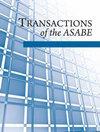Integrating Daily CO2 Concentrations in SWAT-VSA to Examine Climate Change Impacts on Hydrology in a Karst Watershed
IF 1.4
4区 农林科学
Q3 AGRICULTURAL ENGINEERING
引用次数: 1
Abstract
Abstract. Highlights We used SWAT-VSA to assess the effects of climate change with rising CO2 on the water balance of a karst basin. For future climate, SWAT-VSA with rising CO2 yielded 7.1% less ET and 6.3% more runoff than standard SWAT-VSA. Rising CO2 also affected variable source areas, with greater ET declines and runoff increases in the wettest soils. Findings suggest CO2 effects on water balance should be included in future climate change studies with SWAT-VSA. Characterizing the effects of climate change on hydrology is important to watershed management. In this study, we used SWAT-VSA to examine the effects of climate change and increasing atmospheric CO2 (CO2) on the water balance of Spring Creek watershed, a mixed land-use karst basin in the Upper Chesapeake Bay watershed. First, we modified the stomatal conductance and leaf area index (LAI) routines of SWAT-VSA‘s Penman-Monteith evapotranspiration (ET) procedure and enabled the model to accept daily CO2 data. Using downscaled climate projections from nine global climate models (GCMs), we then compared water balance estimations from baseline SWAT-VSA against two modified versions of SWAT-VSA. One SWAT-VSA version integrated daily CO2 levels (SWAT-VSA_CO2), while another version added flexible stomatal conductance and LAI routines (SWAT-VSA_CO2+Plant) to the dynamic CO2 capacity. Under current climate (1985–2015), the three SWAT-VSA models produced generally similar water balance estimations, with 51% of precipitation lost to ET, and the remainder converted to runoff (10%), lateral flow (9%), and percolate (30%). For future climate (2020–2065), water balance simulations diverged between baseline SWAT-VSA and the two modified SWAT-VSA models with CO2. Notably, variable stomatal conductance and leaf area index (LAI) routines produced no detectable effects beyond that of CO2. For the 2020–2065 period, baseline SWAT-VSA projected ET increases of 0.7 mm yr-1, while SWAT-VSA models with CO2 suggested annual ET could decline by approximately -0.4 mm yr-1 over the same period. As a result, the two CO2-based SWAT-VSA models predicted streamflow increases of almost 1.6 mm yr-1 over the 2020–2065 period, which were roughly double the streamflow increases projected by baseline SWAT-VSA. In general, SWAT-VSA models with CO2 effects produced 22.4% more streamflow in 2045–2065 than the SWAT-VSA model without CO2. Results also showed that adding daily CO2 to SWAT-VSA reduced ET in wetter parts of the Spring Creek watershed, leading to greater runoff losses from variable source areas compared to baseline SWAT-VSA. Findings from the study highlight the importance of considering increasing atmospheric CO2 concentrations in water balance simulations with SWAT-VSA in order to gain a fuller appreciation of the hydrologic uncertainties with climate change.在SWAT-VSA中整合日二氧化碳浓度,研究气候变化对喀斯特流域水文的影响
摘要我们利用SWAT-VSA评估了气候变化与CO2上升对喀斯特盆地水平衡的影响。对于未来气候,与标准SWAT-VSA相比,二氧化碳上升的SWAT-VSA产生的ET减少了7.1%,径流增加了6.3%。二氧化碳的增加也影响了变源地区,在最潮湿的土壤中,ET下降幅度更大,径流增加。研究结果表明,二氧化碳对水平衡的影响应纳入未来的SWAT-VSA气候变化研究中。描述气候变化对水文的影响对流域管理具有重要意义。本研究利用SWAT-VSA分析了气候变化和大气CO2 (CO2)增加对上切萨皮克湾混合土地利用喀斯特盆地Spring Creek流域水平衡的影响。首先,我们对SWAT-VSA的Penman-Monteith蒸散发(ET)过程中的气孔导度和叶面积指数(LAI)例程进行了修正,使模型能够接受每日CO2数据。利用9个全球气候模型(GCMs)的缩小尺度气候预估,我们比较了基线SWAT-VSA和两个修改版本的SWAT-VSA的水平衡估计。一个SWAT-VSA版本集成了每日CO2水平(SWAT-VSA_CO2),而另一个版本在动态CO2容量中添加了灵活的气孔导度和LAI例程(SWAT-VSA_CO2+Plant)。在当前气候条件下(1985-2015),三个SWAT-VSA模型得出的水平衡估计大致相似,51%的降水损失为蒸散发,其余转化为径流(10%)、侧流(9%)和渗滤(30%)。对于未来气候(2020-2065),水平衡模拟在基线SWAT-VSA和两个修正的SWAT-VSA模式之间存在差异。值得注意的是,不同的气孔导度和叶面积指数(LAI)常规除了CO2的影响外,没有可检测到的影响。在2020-2065年期间,基线SWAT-VSA预测ET将增加0.7 mm /年,而SWAT-VSA模型显示,在同一时期,二氧化碳的年ET可能会减少约-0.4 mm /年。因此,两个基于二氧化碳的SWAT-VSA模型预测,在2020-2065年期间,河流流量每年增加近1.6毫米,这大约是基线SWAT-VSA预测的河流流量增加的两倍。总的来说,有CO2影响的SWAT-VSA模型在2045-2065年产生的流量比没有CO2影响的SWAT-VSA模型多22.4%。结果还表明,每天向SWAT-VSA中添加二氧化碳会减少Spring Creek流域湿润部分的ET,导致与基线SWAT-VSA相比,可变源区域的径流损失更大。研究结果强调了在SWAT-VSA水平衡模拟中考虑增加大气二氧化碳浓度的重要性,以便更全面地了解气候变化带来的水文不确定性。
本文章由计算机程序翻译,如有差异,请以英文原文为准。
求助全文
约1分钟内获得全文
求助全文
来源期刊

Transactions of the ASABE
AGRICULTURAL ENGINEERING-
CiteScore
2.30
自引率
0.00%
发文量
0
审稿时长
6 months
期刊介绍:
This peer-reviewed journal publishes research that advances the engineering of agricultural, food, and biological systems. Submissions must include original data, analysis or design, or synthesis of existing information; research information for the improvement of education, design, construction, or manufacturing practice; or significant and convincing evidence that confirms and strengthens the findings of others or that revises ideas or challenges accepted theory.
 求助内容:
求助内容: 应助结果提醒方式:
应助结果提醒方式:


